 |
MAB611S-MONEY AND BANKING-2ND OPP-JULY 2024 |
 |
1 Page 1 |
▲back to top |
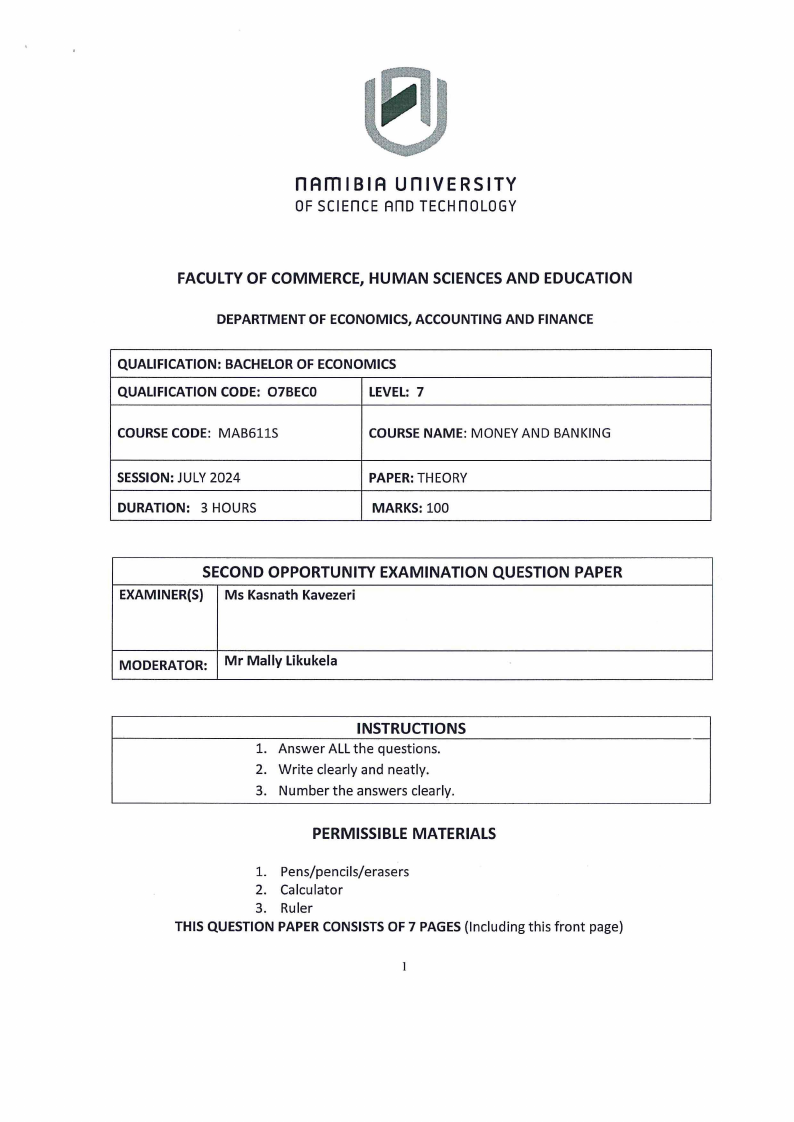
nAm I BIA u n IVE RSITY
OF SCIEnCE TECHn OLOGY
FACULTY OF COMMERCE, HUMAN SCIENCESAND EDUCATION
DEPARTMENT OF ECONOMICS, ACCOUNTING AND FINANCE
QUALIFICATION: BACHELOR OF ECONOMICS
QUALIFICATION CODE: O7BEC0
LEVEL: 7
COURSE CODE: MAB6115
COURSE NAME: MONEY AND BANKING
SESSION: JULY 2024
DURATION: 3 HOURS
PAPER: THEORY
MARKS: 100
SECOND OPPORTUNITY EXAMINATION QUESTION PAPER
EXAMINER(S) Ms Kasnath Kavezeri
MODERATOR: Mr Mally Likukela
INSTRUCTIONS
1. Answer ALL the questions.
2. Write clearly and neatly.
3. Number the answers clearly.
PERMISSIBLE MATERIALS
1. Pens/pencils/erasers
2. Calculator
3. Ruler
THIS QUESTION PAPER CONSISTS OF 7 PAGES (Including this front page)
 |
2 Page 2 |
▲back to top |
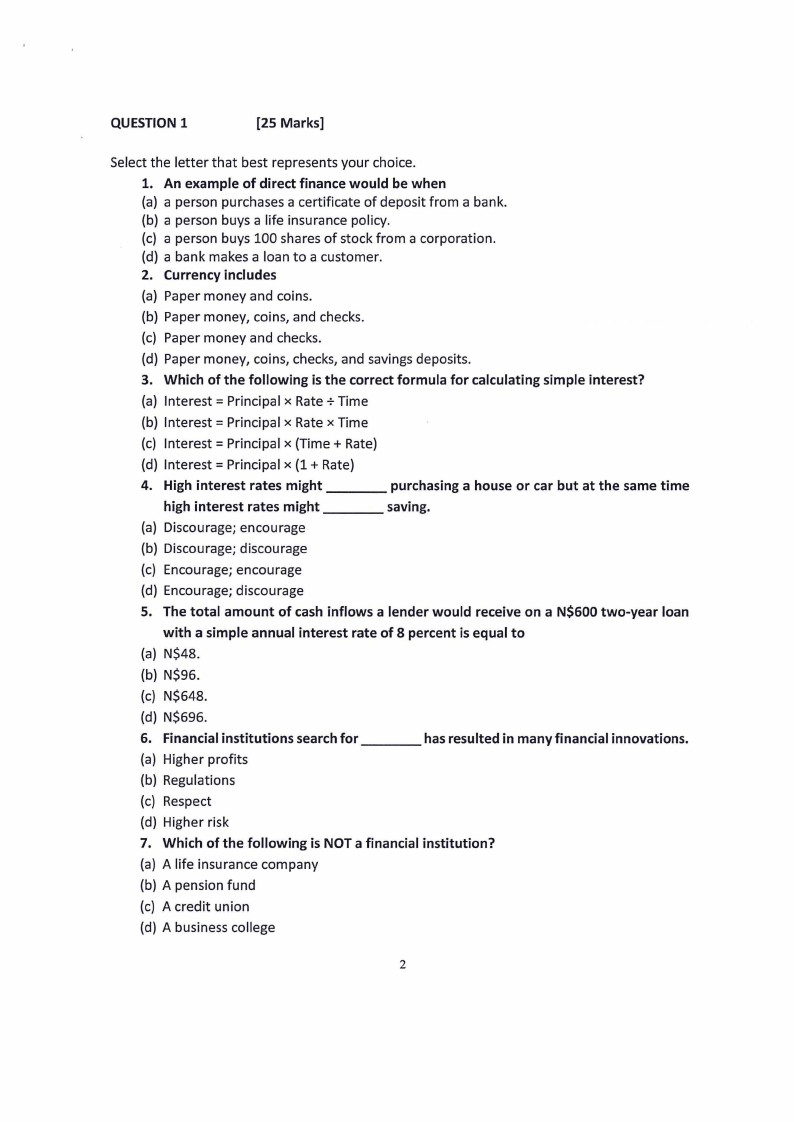
QUESTION 1
[25 Marks]
Select the letter that best represents your choice.
1. An example of direct finance would be when
{a) a person purchases a certificate of deposit from a bank.
{b) a person buys a life insurance policy.
{c) a person buys 100 shares of stock from a corporation.
{d) a bank makes a loan to a customer.
2. Currency includes
{a) Paper money and coins.
{b) Paper money, coins, and checks.
{c) Paper money and checks.
{d) Paper money, coins, checks, and savings deposits.
3. Which of the following is the correct formula for calculating simple interest?
{a) Interest= Principal x Rate+ Time
{b) Interest= Principal x Rate x Time
{c) Interest= Principal x {Time+ Rate)
{d) Interest= Principal x {1 + Rate)
4. High interest rates might ____
purchasing a house or car but at the same time
high interest rates might ____
saving.
(a) Discourage; encourage
{b) Discourage; discourage
{c) Encourage; encourage
{d) Encourage; discourage
5. The total amount of cash inflows a lender would receive on a N$600 two-year loan
with a simple annual interest rate of 8 percent is equal to
{a) N$48.
{b) N$96.
{c) N$648.
{d) N$696.
6. Financial institutions search for ____
has resulted in many financial innovations.
(a) Higher profits
(b) Regulations
(c) Respect
(d) Higher risk
7. Which of the following is NOT a financial institution?
(a) A life insurance company
(b) A pension fund
(c) A credit union
(d) A business college
2
 |
3 Page 3 |
▲back to top |
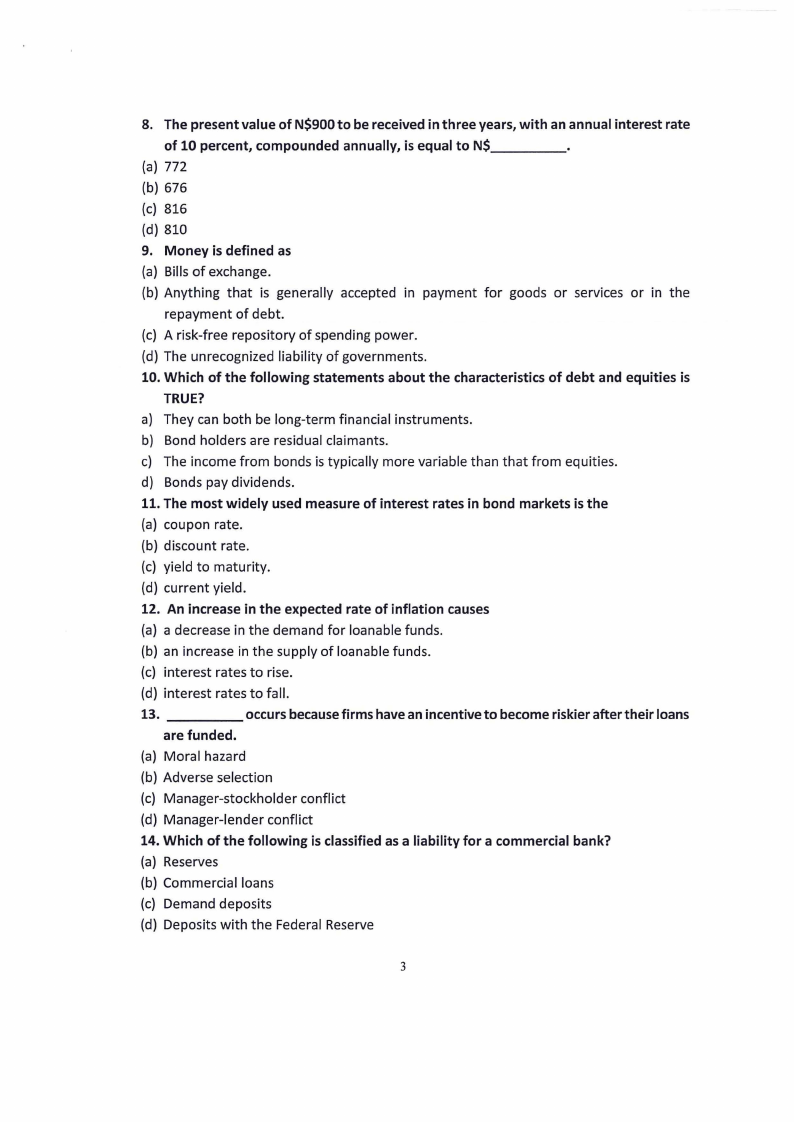
8. The present value of N$900 to be received in three years, with an annual interest rate
of 10 percent, compounded annually, is equal to N$___
_
(a) 772
(b) 676
(c) 816
(d) 810
9. Money is defined as
(a) Bills of exchange.
(b) Anything that is generally accepted in payment for goods or services or in the
repayment of debt.
(c) A risk-free repository of spending power.
(d) The unrecognized liability of governments.
10. Which of the following statements about the characteristics of debt and equities is
TRUE?
a) They can both be long-term financial instruments.
b) Bond holders are residual claimants.
c) The income from bonds is typically more variable than that from equities.
d) Bonds pay dividends.
11. The most widely used measure of interest rates in bond markets is the
(a) coupon rate.
(b) discount rate.
(c) yield to maturity.
(d) current yield.
12. An increase in the expected rate of inflation causes
(a) a decrease in the demand for loanable funds.
(b) an increase in the supply of loanable funds.
(c) interest rates to rise.
(d) interest rates to fall.
13. _____
occurs because firms have an incentive to become riskier after their loans
are funded.
(a) Moral hazard
(b) Adverse selection
(c) Manager-stockholder conflict
(d) Manager-lender conflict
14. Which of the following is classified as a liability for a commercial bank?
(a) Reserves
(b) Commercial loans
(c) Demand deposits
(d) Deposits with the Federal Reserve
3
 |
4 Page 4 |
▲back to top |
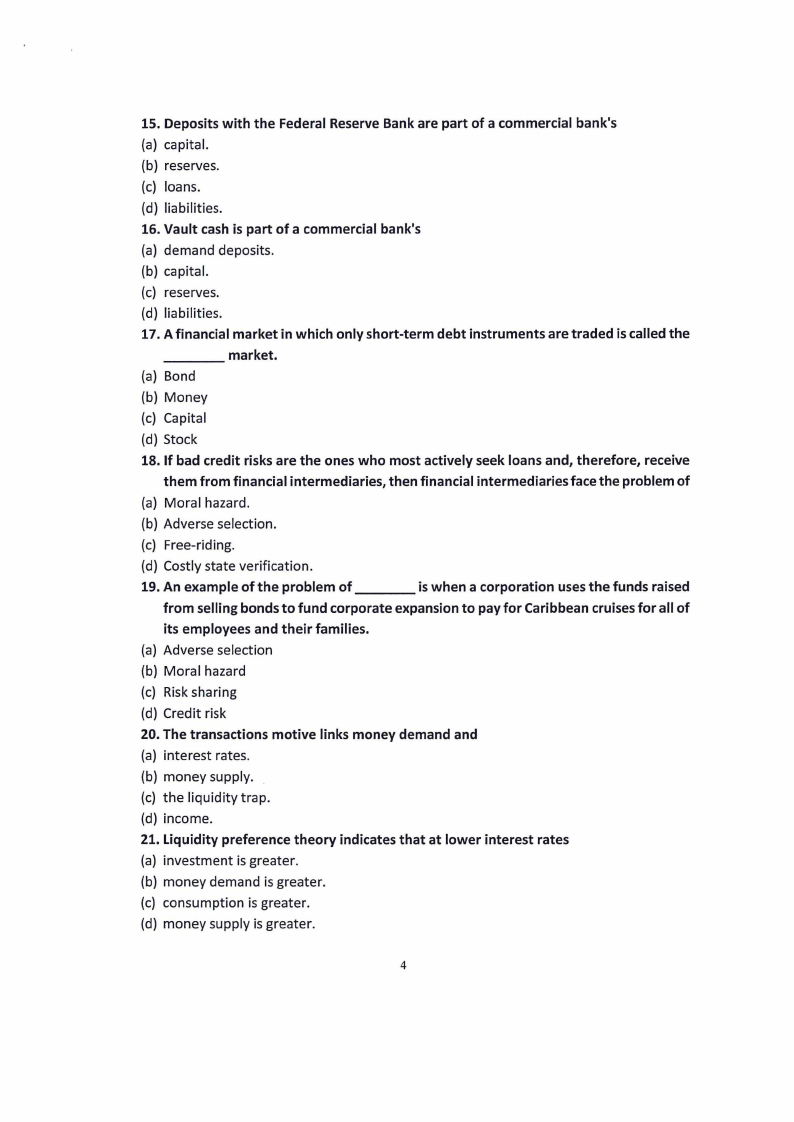
15. Deposits with the Federal Reserve Bank are part of a commercial bank's
(a) capital.
(b) reserves.
(c) loans.
(d) liabilities.
16. Vault cash is part of a commercial bank's
(a) demand deposits.
(b) capital.
(c) reserves.
(d) liabilities.
17. A financial market in which only short-term debt instruments are traded is called the
____
market.
(a) Bond
(b) Money
(c) Capital
(d) Stock
18. If bad credit risks are the ones who most actively seek loans and, therefore, receive
them from financial intermediaries, then financial intermediaries face the problem of
(a) Moral hazard.
(b) Adverse selection.
(c) Free-riding.
(d) Costly state verification.
19. An example of the problem of ___
is when a corporation uses the funds raised
from selling bonds to fund corporate expansion to pay for Caribbean cruisesfor all of
its employees and their families.
(a) Adverse selection
(b) Moral hazard
(c) Risk sharing
(d) Credit risk
20. The transactions motive links money demand and
(a) interest rates.
(b) money supply.
(c) the liquidity trap.
(d) income.
21. Liquidity preference theory indicates that at lower interest rates
(a) investment is greater.
(b) money demand is greater.
(c) consumption is greater.
(d) money supply is greater.
4
 |
5 Page 5 |
▲back to top |
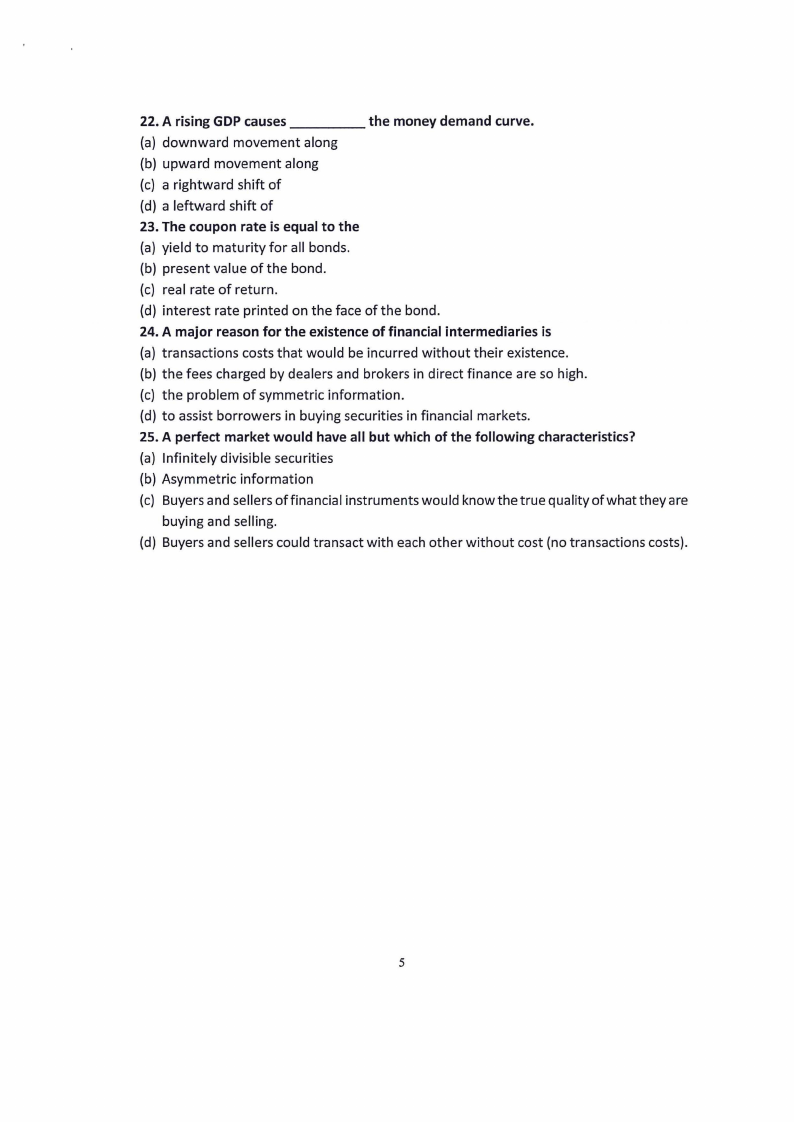
22. A rising GDP causes ____
the money demand curve.
(a) downward movement along
(b) upward movement along
(c) a rightward shift of
(d) a leftward shift of
23. The coupon rate is equal to the
(a) yield to maturity for all bonds.
(b) present value of the bond.
(c) real rate of return.
(d) interest rate printed on the face of the bond.
24. A major reason for the existence of financial intermediaries is
(a) transactions costs that would be incurred without their existence.
(b) the fees charged by dealers and brokers in direct finance are so high.
(c) the problem of symmetric information.
(d) to assist borrowers in buying securities in financial markets.
25. A perfect market would have all but which of the following characteristics?
(a) Infinitely divisible securities
(b) Asymmetric information
(c) Buyers and sellers offinancial instruments would know the true quality of what they are
buying and selling.
(d) Buyers and sellers could transact with each other without cost (no transactions costs).
5
 |
6 Page 6 |
▲back to top |
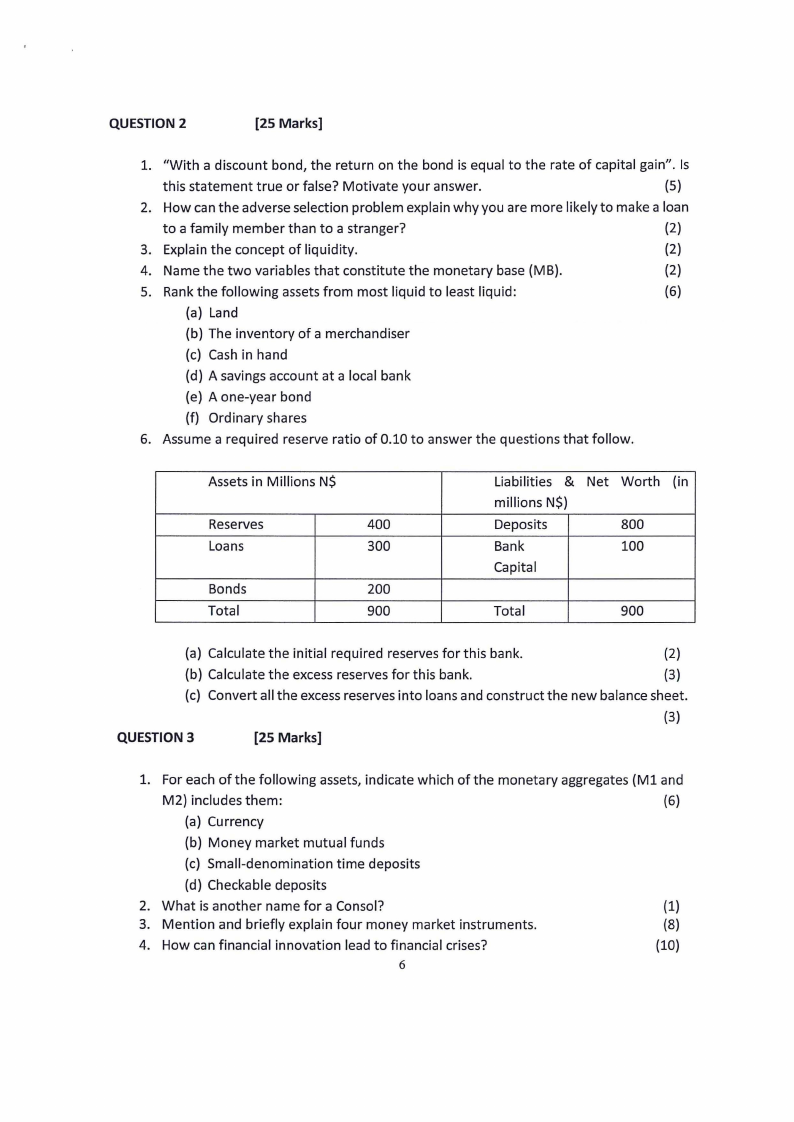
QUESTION 2
[25 Marks]
1. 11With a discount bond, the return on the bond is equal to the rate of capital gain". Is
this statement true or false? Motivate your answer.
(5)
2. How can the adverse selection problem explain why you are more likely to make a loan
to a family member than to a stranger?
(2)
3. Explain the concept of liquidity.
(2)
4. Name the two variables that constitute the monetary base (MB).
(2)
5. Rank the following assets from most liquid to least liquid:
(6)
(a) Land
(b) The inventory of a merchandiser
(c) Cash in hand
(d) A savings account at a local bank
(e) A one-year bond
(f) Ordinary shares
6. Assume a required reserve ratio of 0.10 to answer the questions that follow.
Assets in Millions N$
Reserves
400
Loans
300
Bonds
200
Total
900
Liabilities & Net Worth (in
millions N$)
Deposits
800
Bank
100
Capital
Total
900
(a) Calculate the initial required reserves for this bank.
(2)
(b) Calculate the excess reserves for this bank.
(3)
(c) Convert all the excess reserves into loans and construct the new balance sheet.
(3)
QUESTION 3
[25 Marks]
1. For each of the following assets, indicate which of the monetary aggregates (Ml and
M2) includes them:
(6)
(a) Currency
(b) Money market mutual funds
(c) Small-denomination time deposits
(d) Checkable deposits
2. What is another name for a Consol?
(1)
3. Mention and briefly explain four money market instruments.
(8)
4. How can financial innovation lead to financial crises?
(10)
6
 |
7 Page 7 |
▲back to top |
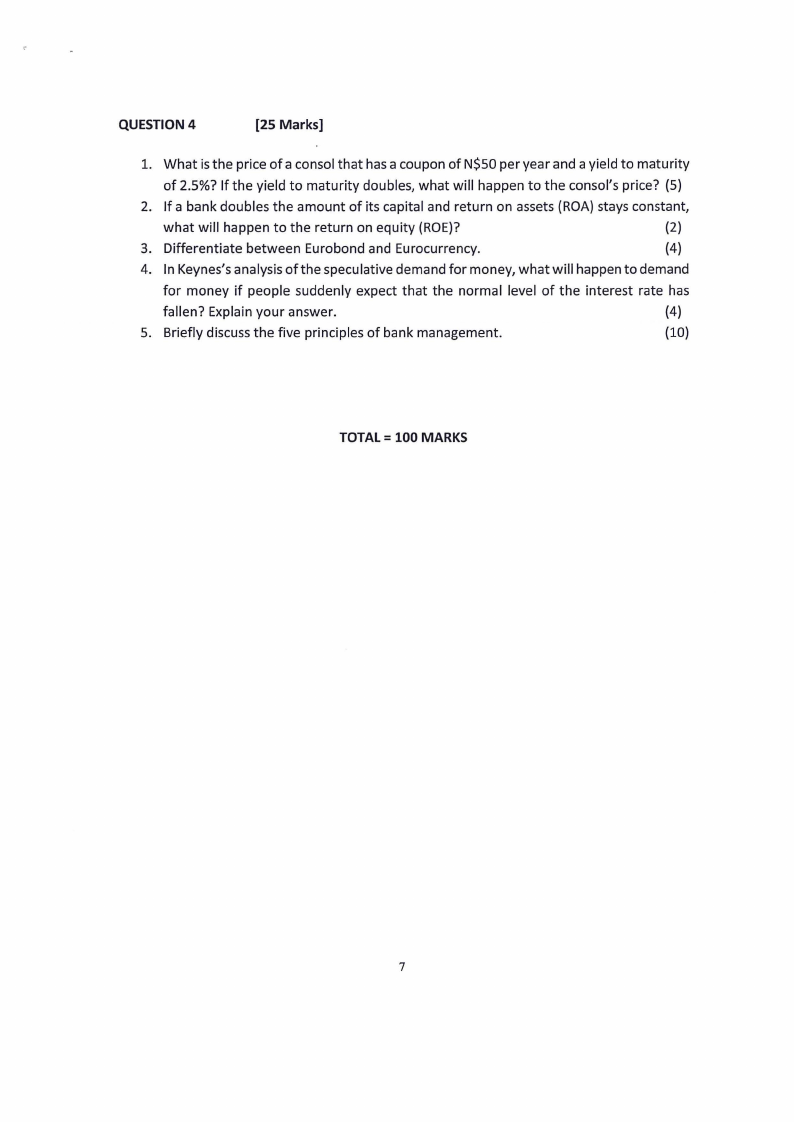
QUESTION 4
[25 Marks]
1. What is the price of a consol that has a coupon of N$50 per year and a yield to maturity
of 2.5%? If the yield to maturity doubles, what will happen to the consol's price? (5)
2. If a bank doubles the amount of its capital and return on assets (ROA) stays constant,
what will happen to the return on equity (ROE)?
(2)
3. Differentiate between Eurobond and Eurocurrency.
(4)
4. In Keynes's analysis of the speculative demand for money, what will happen to demand
for money if people suddenly expect that the normal level of the interest rate has
fallen? Explain your answer.
(4)
5. Briefly discuss the five principles of bank management.
(10)
TOTAL= 100 MARKS
7





